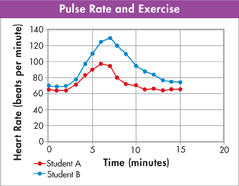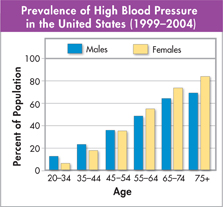Use Models Construct a simple stethoscope out of rubber tubing and a metal funnel. Listen for the sounds of air rushing into and out of your lungs and record a description. How does the sound change when you cough?
Interpret Graphs At about which minute did each student reach his or her highest heart rate?
Draw Conclusions Which of the two students is most likely in better physical condition? What evidence from the graph supports your answer?
Predict What other changes in the circulatory and respiratory systems would you expect to take place in the time interval shown?
Explanation Make a list of the things you do that affect your circulatory and respiratory systems. After completing your list, place a check mark next to those that are harmful. Pick one harmful habit and write a paragraph explaining how you could change or break it.
Assess the
 Describe the relationship between the human circulatory system and the respiratory system. How does the proper functioning of those systems affect other body systems?
Describe the relationship between the human circulatory system and the respiratory system. How does the proper functioning of those systems affect other body systems?Interpret Graphs In what age group do women start to have a higher incidence of high blood pressure than men?
Calculate Between which age groups do you find the largest percentage increase in cases of high blood pressure?

women between 20–34 and 35–44 years of age
men between 20–34 and 35–44 years of age
women between 55–64 and 65–74 years of age
men between 45–54 and 55–64 years of age
Connecting Concepts
Use Science Graphics
The following graph is based on pulse rates taken each minute for two students doing the same exercises. The exercises begin at minute 1 and end at minute 8. Use the graph to answer questions 32–34.
Write About Science
Analyzing Data
High blood pressure is a major risk factor for heart disease in the United States. By age 44, about 25 percent of Americans have high blood pressure, and many of them do not know it. Use the graph to answer questions 37 and 38.
Table of Contents
- Formulas and Equations
- Applying Formulas and Equations
- Mean, Median, and Mode
- Estimation
- Using Measurements in Calculations
- Effects of Measurement Errors
- Accuracy
- Precision
- Comparing Accuracy and Precision
- Significant Figures
- Calculating With Significant Figures
- Scientific Notation
- Calculating With Scientific Notation
- Dimensional Analysis
- Applying Dimensional Analysis






